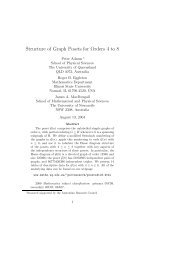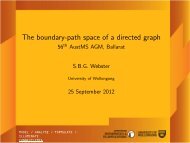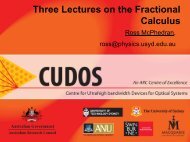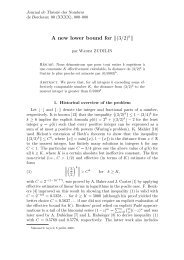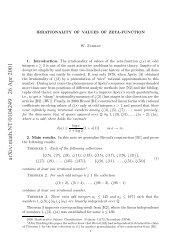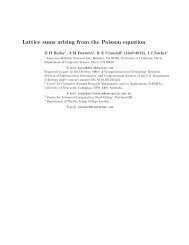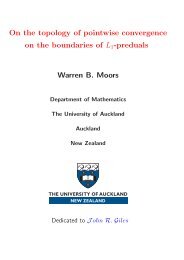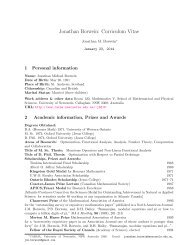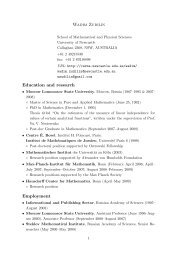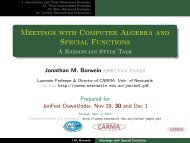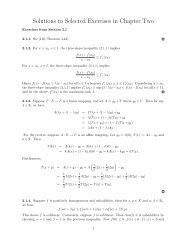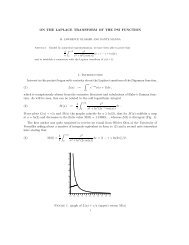QUADRATIC CONVERGENCE OF THE TANH-SINH ...
QUADRATIC CONVERGENCE OF THE TANH-SINH ...
QUADRATIC CONVERGENCE OF THE TANH-SINH ...
Create successful ePaper yourself
Turn your PDF publications into a flip-book with our unique Google optimized e-Paper software.
<strong>QUADRATIC</strong> <strong>CONVERGENCE</strong> <strong>OF</strong> <strong>THE</strong> <strong>TANH</strong>-<strong>SINH</strong> QUADRATURE RULE 13where(4.17) sgn(z) =Therefore{1, Re(z)> 0−1, Re(z)< 0.Φ(arcsinh(sinh(z) + (2n − 1)i)) = Φ(A(z, n) + B(z, n)i)Φ(arcsinh(sinh(z) − (2n − 1)i)) = Φ(A(z, n) − B(z, n)i)and()−1H n (z) = 2πi1 − exp( 2πB(z,n)−i2πA(z,n)h) + 11 − exp( 2πB(z,n)+i2πA(z,n)h)(4.18)=By (4.15) and (4.16),(4.19)−4π sin( 2πA(z,n)h) exp( 2πB(z,n)1 − 2 exp( 2πB(z,n)h‖Êh‖ 2 = −2= −2∞∑r=1∞∑∫ ∞r=1 n=1−∞ n=1∫ ∞∞∑) cos( 2πA(z,n)h∞∑−∞h)) + exp( 4πB(z,n)h)π cosh(x)sinh(π sinh(x)) H n(x) cos(2πrx/h) dxπ cosh(x)sinh(π sinh(x)) H n(x) cos(2πrx/h) dxUsing a more elaborate (and computer algebra assisted) version of the argumentgiven by [1] for tanh, we can estimate e 1 by(4.20) e 1 = ‖Êh‖ 2 = O(e −A/h)where A is a positive constant. This entails integrating the integral component of(4.19) by parts twice to obtain(4.21)∫ ∞π cosh(x)H n (x)−∞ sinh(π sinh(x)) cos(2πrx/h)dx( ) 2 ∫ h ∞() ′′π cosh(x)= −H n (x)cos (2πrx/h) dx.2πrsinh(π sinh(x))−∞which is( ) e−A/hOr 2 n 2Our numerical experiments indicate that A is some constant bounded below by 5/2and above by 10.4.3. Evaluation of e 4 . We have:e 4 = ̂σ h,N,(z)̂σ h,N,(w) ̂K(z, w)= h2 π 2 ∑4X|r|,|n|>Nwhich can be written ash 2 π 2(4.22)2r,n>Ncosh(nh) cosh(rh)cosh ( π2 sinh(nh) − π 2 sinh(rh)) cosh ( π2 sinh(nh)) cosh ( π2 sinh(rh))sinh(rh)cosh(nh) cosh(rh)cosh π sinh(nh) − π sinh(rh)cosh π sinh(nh)cosh π 2 2 2 2



